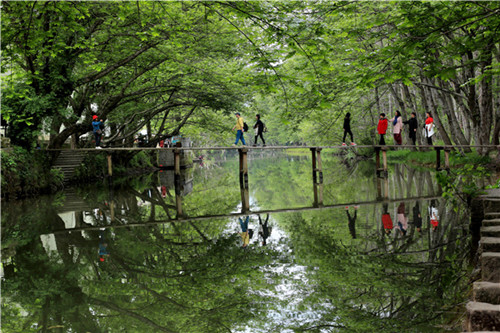China's ecological quality of vegetation still rising
Author : Li Hongyang Source : China Daily 2020-05-07

Visitors walk on a bridge at a wetland park in Huangshan, Anhui province, on April 10, 2020. [Photo by Shi Guangde/For China Daily]
The ecological quality of China's vegetation has remained on a positive trend since 2000, according to the Bulletin of National Ecological Meteorology 2019.
The bulletin, released by the China Meteorological Administration at a news conference recently, primarily focused on evaluating growth of vegetation and how well plants play their role in improving the ecosystem under the influence of meteorological factors.
The bulletin indicated that last year, the national vegetation ecological quality index, a synthetic calculation of coverage and carbon fixation ability of vegetation, reached 67.6, up 6.1 percent on average compared with normal years since 2000.
So far, 92 percent of the country's land area has been "covered by growing green plants", especially central and eastern parts whose indexes have increased by between 0.25 and 1.5 percentage points per year on average.
However, indexes continue to decline in western regions like Sichuan province, Yunnan province and Tibet autonomous region, the bulletin said.
With more vegetation coverage, the country has significantly improved its windbreak and sand fixation capabilities, particularly in North China, according to the bulletin.
It showed areas that are extremely likely to have fine dust have decreased from 48.1 percent in 2000 to 41.9 percent last year.
Areas with light fine dust or that are dust-free have increased from 30.3 percent in 2000 to 39.6 percent last year thanks to an increase of 2.3 millimeters' precipitation per year and proper management of the sand sources.
The grassland has also seen carbon fixation ability rise by absorbing five to 20 more grams of carbon per square meter than that of last year in areas including the Inner Mongolia autonomous region as well as northeastern, northwestern, and northern parts of China
According to the bulletin, last year grassland across the country accumulated 458.1 grams of carbon per square meter, the second largest since 2000.
Last year, in Qinghai province, herbage production increased by 10 percent compared with the previous year. In addition, production rose by 50 percent year-on-year in the western parts of Sichuan, the bulletin showed.
Wang Zhihua, a senior official with the administration, said that the improvements were due to a continuous ecological protection project by the central government and an increase in rainfall.
"Over the past two decades, projects such as returning farmland to forests and grassland and the Three-North Shelter Forest Program have helped improve the vegetation quality," he said.
"The favorable condition with higher temperatures and more rain last year also facilitated vegetation growth," he said.
Ye Shengtao made Chinese fairy tales from a wilderness
Ye Shengtao (1894–1988) created the first collection of fairy tales in the history of Chinese children’s literature...
-
How northern ethnicities integrated into Chinese nation
2023-09-18
-
Mogao caves
2023-09-12
-
Mogao Grottoes as ‘a place of pilgrimage’
2023-09-12
-
Time-honored architectural traditions in China
2023-08-29
-
Disentangling the civilizational evolution of China
2023-08-28
-
AI ethics in science fiction
2023-08-23














 2011-2013 by www.cssn.cn. All Rights Reserved
2011-2013 by www.cssn.cn. All Rights Reserved